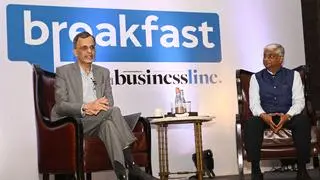The allocation for the Mahatma Gandhi National Rural Employment Guarantee Act 2005 has been slashed by 25 per cent in the current budget, compared to the estimates from the last financial year. While the revised estimates for the scheme in FY 2021-22 was ₹97,034.7 crore, the allocation for the current financial year is ₹72,034.67 crore.
The scheme that was introduced in 2005 saw maximum allocation in the pandemic year when the demand for MGNREGA jobs was at an all-time high. In 2020-21, the government had allocated ₹1,10,527 crore towards this. According to the 2022 Economic Survey, MGNREGA employment peaked during the lockdown in 2020, owing to pandemic. While the demand came down by September 2020, after relaxations were introduced, the demand rose again, from the beginning of 2021, until the second wave’s peak was crossed. The survey says that the demand is still higher than that of the pre-Covid times.
Related Stories
PLFS data: What the numbers hide
The sharp spike in labour participation rates in the latest survey is difficult to reconcile with earlier years’ data“During the nationwide lockdown, the aggregate demand for MGNREGS work peaked in June 2020 and has thereafter stabilised. During the second-Covid wave, demand for MGNREGS employment reached the maximum level of 4.59 crore persons in June 2021. Nonetheless, after accounting for seasonality, the demand at an aggregate level still seems to be above the pre-pandemic levels of 2019,” says the survey. At the same time, the survey says that the relationship between MGNREGS employment and the movement of migrant labour during the last two years cannot be conclusively determined.
MGNREGA ensures 100 days of employment to people registered under it. Their wages differ from ₹309 to ₹190 per day, depending on the State where they are employed. Currently, the wages are the maximum in Haryana and the lowest in Chhattisgarh.

Are these funds enough?
“When the pandemic hit and we witnessed a reverse migration, MGNREGA is what saved thousands of people from starvation,” says former civil servant and founder of the Mazdoor Kisan Shakti Sangathan, Aruna Roy. Commenting that the budget was biased against the poor of the country, she says that allocation should have been at least 25 per cent higher than the previous year’s allocation.
Roy also points at a study by Peoples’ Action for Employment Guarantee, an academics’ group that conducts research on MGNREGA. The study says that allocation for the scheme should have been ideally ₹2.64 Lakh Crores, to provide 100 days of employment to 6.68 crore people.
However, Dr Ramanand Nand, who heads the Centre for Policy Research and Governance paints a slightly different picture. He points out that the allocation during FY 2019- 20 (₹71,216) and FY 22-23 are similar and says that this could be because things are improving. “Restrictions have eased and this may mean that people are now going back to cities,” says Dr Nand. “The government ramped up the initial allocation by multifold in 2020-21. The same happened in 2021-22 as well. This year too, we can expect it to do so if there is a need,” he adds.
‘Time to rethink policies’
Observing that the allocations are sufficient in the current situation, he also looks at the possibility of merging MNREGA with other schemes. “MNREGA was introduced way back in 2006 and it is high time to rethink the policies in such a way that we improve the quality of work done under it. The government can merge it with more schemes and work on skilling the labourers. That is definitely the way forward,” he said.
Since the budget, there has been a lot of hue and cry from various circles, seeking a higher allocation and alleging that NREGA has pending liabilities of ₹18,350 Crore. This is based on the data available on the NREGA portal. However, according to the data shared by Sadhvi Niranjan Jyoti, Minister of State, Ministry of Rural Development, in the Rajya Sabha, the liability is only Rs 3,358.14 crore, as of January 27, 2022. The data was shared on February 3, while answering a question by CPM MP John Brittas.








Comments
Comments have to be in English, and in full sentences. They cannot be abusive or personal. Please abide by our community guidelines for posting your comments.
We have migrated to a new commenting platform. If you are already a registered user of TheHindu Businessline and logged in, you may continue to engage with our articles. If you do not have an account please register and login to post comments. Users can access their older comments by logging into their accounts on Vuukle.